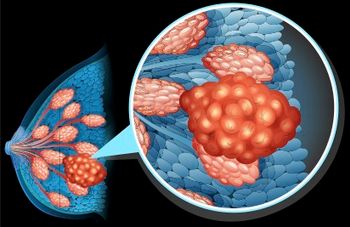
Oncology NEWS International
- Oncology NEWS International Vol 13 No 1
- Volume 13
- Issue 1
Physical Examination Is Still Important for Detecting Breast Ca, Especially in Young Women
SALT LAKE CITY-Physical examination of the breasts by a woman and her health care provider remains an important means of detecting breast cancer, especially in young women, according to a study reported at the 45th Annual Meeting of the American Society for Therapeutic Radiology and Oncology (abstract 194). The study found that physical examination was the sole method of breast cancer detection in nearly half of women younger than 40.
SALT LAKE CITYPhysical examination of the breasts by a woman and her health care provider remains an important means of detecting breast cancer, especially in young women, according to a study reported at the 45th Annual Meeting of the American Society for Therapeutic Radiology and Oncology (abstract 194). The study found that physical examination was the sole method of breast cancer detection in nearly half of women younger than 40.
"The purpose of this study was to look at the characteristics and outcomes of women in whom physical examination was the sole method of breast cancer detection. In other words, we were looking at women whose cancers presented as palpable breast masses and whose mammograms were negative," said lead author Hasmik Diratzouian, MD, a resident in radiation oncology at Fox Chase Cancer Center, Philadelphia.
Dr. Diratzouian and her colleagues retrospectively studied 2,431 women who had stage I or II breast cancer (including T1 and T2 tumors) and who were treated with breast-conserving surgery, axillary node dissection, and adjuvant radiation therapy, with or without systemic therapy, between 1970 and 1999. The patients had a median age of 56 years (range, 22 to 93 years).
Outcomes were assessed over a median duration of 82 months and compared with respect to clinical factors (age, tumor size, family history, and detection method); pathologic factors (nodal status, an extensive intraductal component, lymphovascular invasion, final margin status, and tumor grade); and treatment-related factors (use of chemotherapy and use of tamoxifen).
Nearly half of the women (46%) had both an abnormal mammogram and an abnormal physical exam (breast self-exam and/or clinical breast exam), and about one third (35%) had an abnormal mammogram but a normal physical exam. However, a substantial proportion (19%) had an abnormal physical exam but a normal mammogram, she said.
Significantly larger proportions of cancers detected by physical exam alone than of cancers detected by mammography alone occurred in women who were younger than age 40 (25% vs 2%), had large (T2) tumors (30% vs 11%), had axillary node involvement (30% vs 15%), and were treated with chemotherapy (39% vs 15%).
"Looking a little more closely at the young women, we found that in women under 40 years of age, physical exam was the sole method of detection in 45% of cases. In contrast, in those over age 50, 44% of those cancers were detected by an abnormal mammogram and normal breast exam," Dr. Diratzouian noted.
Better Outcomes
Compared with women who had an abnormal mammogram alone, those who had an abnormal physical exam alone had a higher estimated 10-year rate of locoregional control (94% vs 88%). In a multivariate analysis, the factors significantly associated with locoregional control were detection by physical exam alone and treatment with tamoxifen, both of which predicted better control.
Dr. Diratzouian acknowledged that better locoregional control of relatively more advanced cancers occurring in younger women seems counterintuitive. "I think one hypothesis is that for these tumors to grow to a large size and have other negative characteristics associated with them and yet not to metastasize perhaps tells us something about the natural history of these tumors. Perhaps there are factors associated with them that are unknown to us that make them less predisposed to metastasizing. Also, I think that these are the women who received chemotherapy more frequently," she said.
Compared with women who had only an abnormal mammogram, women who had only an abnormal physical exam also had a higher estimated 10-year rate of overall survival (84% vs 77%). In a multivariate analysis, the factors significantly associated with overall survival were larger T stage, positive lymphadenopathy, and younger age, all of which predicted poorer survival.
Although breast cancers detected by physical exam alone tend to have more adverse prognostic features, these cancers are not associated with poorer outcomes, Dr. Diratzouian said. "Physical exam remains an important method of detection of breast cancer, particularly for younger women for whom mammography is less sensitive and not performed as frequently," she concluded.
Articles in this issue
almost 22 years ago
Stopping Smoking May Increase Breast Cancer Survivalalmost 22 years ago
Neoadjuvant Anastrozole Permits Breast Conservationalmost 22 years ago
Antisense May Potentiate DTIC Efficacyalmost 22 years ago
3D Virtual Colonoscopy as Sensitive as Conventional TestNewsletter
Stay up to date on recent advances in the multidisciplinary approach to cancer.


















































































